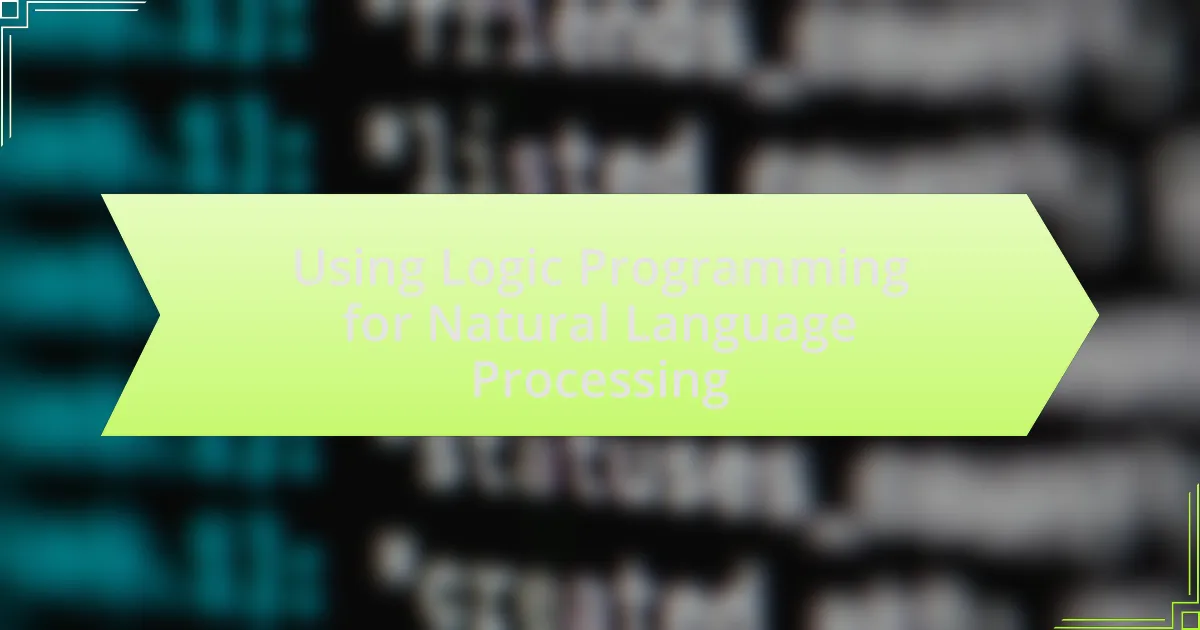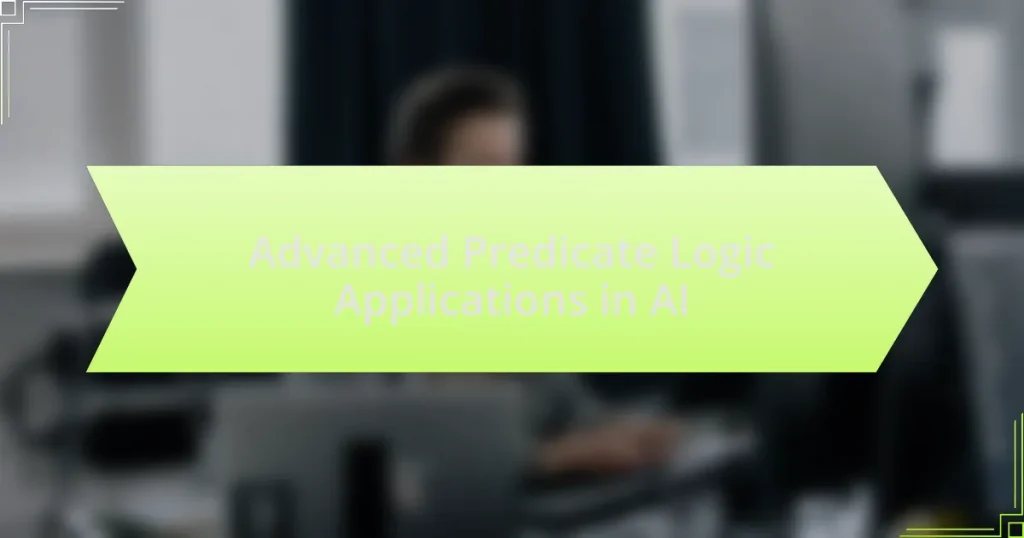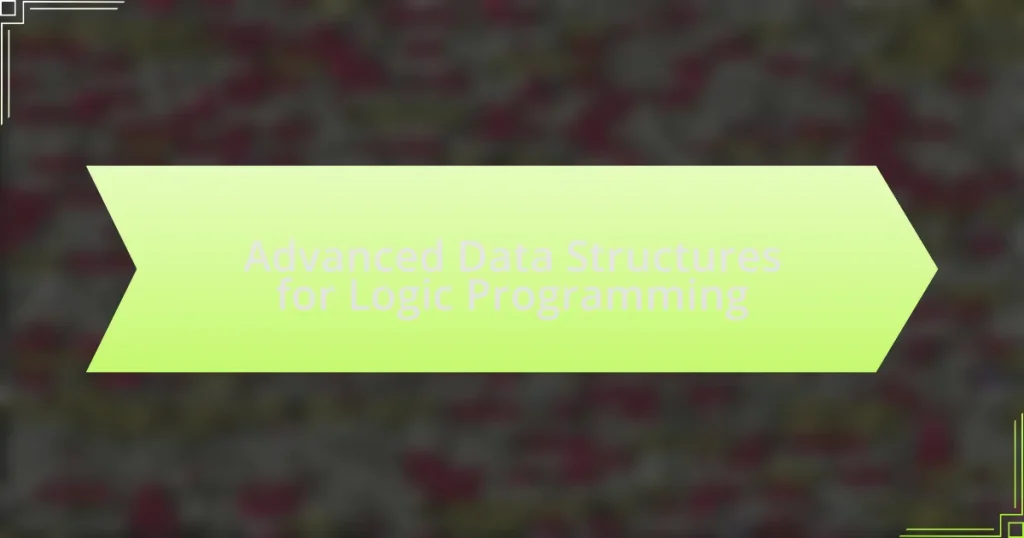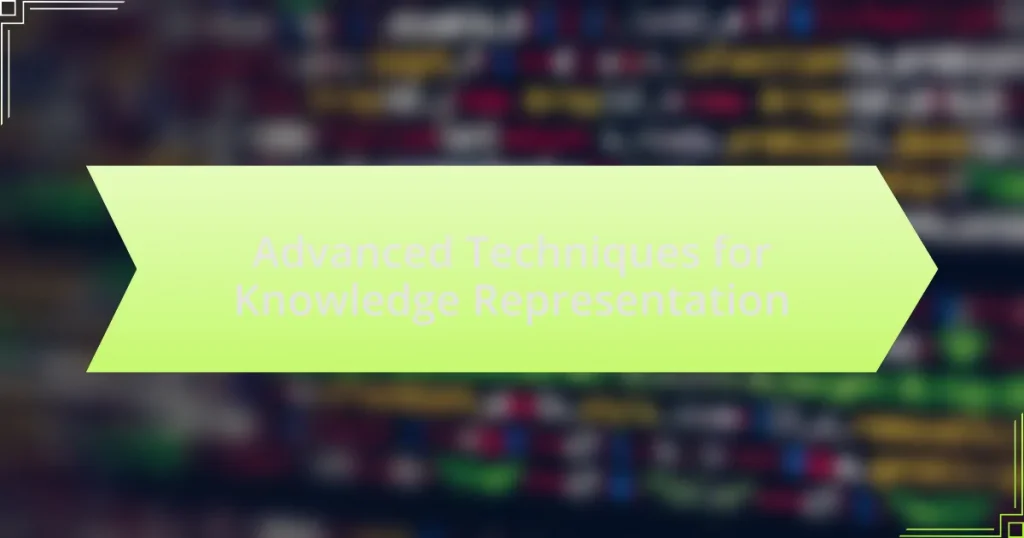Logic programming, particularly through languages like Prolog, serves as a foundational paradigm in natural language processing (NLP) by utilizing formal logic to represent knowledge and facilitate reasoning. This article explores the principles of logic programming, its distinctiveness from other programming paradigms, and its applications in syntax and semantic analysis within NLP. It addresses the challenges faced in handling ambiguity and performance issues, while also highlighting the integration of logic programming with machine learning techniques. Furthermore, the article discusses real-world applications, future developments, and practical tips for effectively utilizing logic programming in NLP projects.
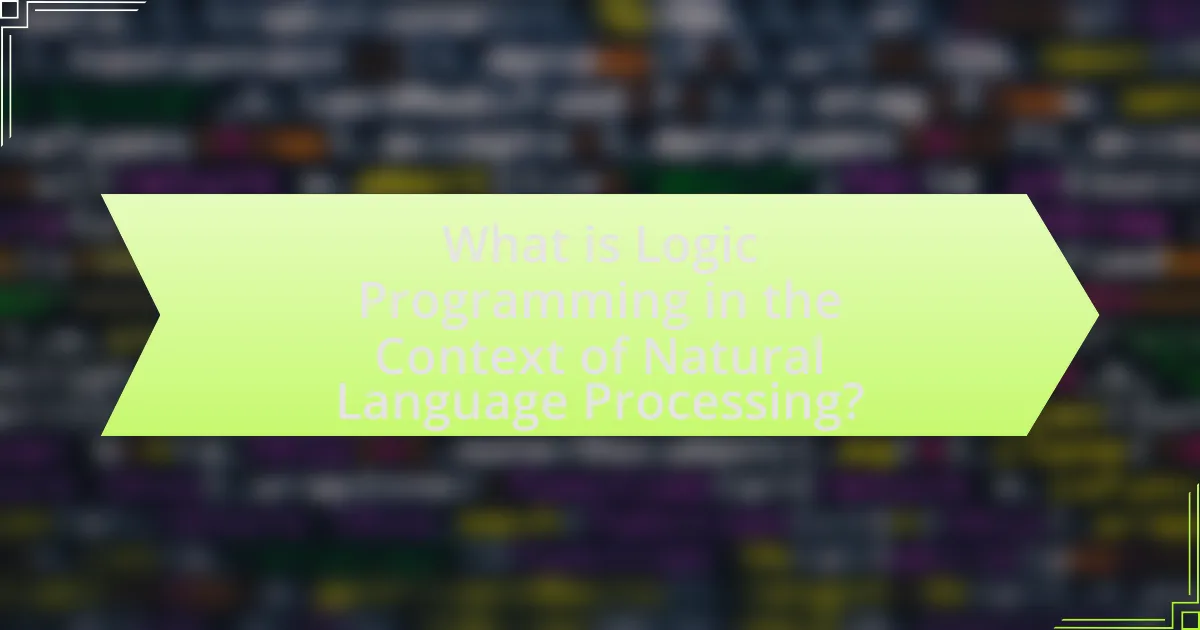
What is Logic Programming in the Context of Natural Language Processing?
Logic programming in the context of natural language processing (NLP) is a programming paradigm that uses formal logic to represent knowledge and infer conclusions. This approach allows for the creation of systems that can understand and generate human language by defining rules and relationships in a logical format. For instance, Prolog, a well-known logic programming language, enables the representation of linguistic structures and the execution of queries to derive meaning from natural language inputs. The effectiveness of logic programming in NLP is evidenced by its application in tasks such as semantic parsing, where it helps in mapping sentences to their logical forms, facilitating better understanding and reasoning about language.
How does Logic Programming differ from other programming paradigms?
Logic programming differs from other programming paradigms primarily in its use of formal logic as a basis for computation. In logic programming, programs consist of a set of sentences in logical form, expressing facts and rules about a problem domain, which allows for automated reasoning and inference. This contrasts with imperative programming, where the focus is on how to perform tasks through a sequence of commands, and object-oriented programming, which centers around objects and their interactions. Logic programming languages, such as Prolog, enable declarative problem-solving, allowing programmers to specify what the solution should satisfy rather than detailing the steps to achieve it. This paradigm is particularly effective in fields like natural language processing, where reasoning about language structure and meaning is essential.
What are the fundamental principles of Logic Programming?
The fundamental principles of Logic Programming include the use of formal logic as a programming paradigm, where programs are expressed in terms of relations and rules rather than procedures. Logic Programming is based on the concept of a knowledge base, which consists of facts and rules that define relationships between entities. The execution of a Logic Program involves querying this knowledge base to derive conclusions through a process called resolution, which systematically applies logical inference rules to derive new information from existing facts. This paradigm is exemplified by languages such as Prolog, which utilize a declarative approach, allowing programmers to focus on what the program should accomplish rather than how to achieve it. The correctness of Logic Programming is supported by its foundation in mathematical logic, ensuring that the conclusions drawn from the knowledge base are logically valid.
How does Logic Programming facilitate reasoning in NLP?
Logic Programming facilitates reasoning in NLP by providing a formal framework for representing knowledge and inference. This framework allows for the encoding of rules and facts in a way that machines can process logically, enabling automated reasoning about language. For instance, Prolog, a well-known logic programming language, uses a set of logical statements to derive conclusions from given data, which is essential for tasks like semantic parsing and question answering. The ability to express complex relationships and perform logical deductions makes Logic Programming a powerful tool in NLP applications, enhancing the system’s capability to understand and manipulate natural language effectively.
What role does Logic Programming play in Natural Language Processing?
Logic Programming plays a crucial role in Natural Language Processing (NLP) by providing a formal framework for representing and reasoning about linguistic knowledge. This approach allows for the creation of grammars and semantic representations that can be easily manipulated and queried. For instance, Prolog, a prominent logic programming language, enables the implementation of rule-based systems that can infer relationships and meanings from natural language inputs. Research has shown that logic-based methods enhance the accuracy of parsing and understanding complex sentences, as evidenced by studies demonstrating improved performance in tasks such as semantic parsing and question answering.
How can Logic Programming be applied to syntax analysis?
Logic programming can be applied to syntax analysis by utilizing formal grammars to define the structure of languages, enabling the parsing of sentences based on logical rules. In this context, logic programming languages like Prolog allow for the representation of grammatical rules as facts and rules, facilitating the construction of parsers that can deduce the syntactic structure of sentences. For instance, Prolog’s backtracking mechanism efficiently explores possible parse trees, ensuring that all valid interpretations of a sentence are considered. This approach has been validated in various studies, demonstrating its effectiveness in handling complex syntactic structures and ambiguities in natural language processing tasks.
What are the implications of using Logic Programming for semantic analysis?
Using Logic Programming for semantic analysis enhances the ability to represent and reason about knowledge in a structured manner. This approach allows for the formalization of semantics through rules and facts, enabling systems to infer new information and resolve ambiguities in natural language. For instance, Prolog, a prominent logic programming language, facilitates the creation of knowledge bases that can be queried to derive meanings based on logical relationships. The implications include improved accuracy in understanding context, the ability to handle complex queries, and the potential for automated reasoning, which can significantly enhance applications in natural language processing, such as question answering and information retrieval.
What are the challenges of using Logic Programming in NLP?
The challenges of using Logic Programming in NLP include difficulty in handling ambiguity, limited expressiveness for certain linguistic phenomena, and performance issues with large datasets. Logic Programming relies on formal rules and structures, which can struggle to represent the inherent ambiguity of natural language, such as polysemy and context-dependent meanings. Additionally, while Logic Programming is powerful for certain logical constructs, it may lack the expressiveness needed for capturing complex syntactic and semantic relationships found in natural language. Performance can also be a concern, as inference in Logic Programming can be computationally intensive, particularly when processing large corpora or real-time applications. These challenges highlight the limitations of Logic Programming in effectively addressing the complexities of natural language.
What limitations does Logic Programming face in handling ambiguity?
Logic programming faces significant limitations in handling ambiguity due to its reliance on strict logical rules and deterministic outcomes. This rigidity makes it challenging to interpret ambiguous language, as logic programming systems require clear, unambiguous predicates to function effectively. For instance, natural language often contains polysemy, where a single word can have multiple meanings, and logic programming struggles to resolve these meanings without additional contextual information. Furthermore, the inability to incorporate probabilistic reasoning limits the capacity of logic programming to manage uncertainty inherent in natural language, as it cannot easily adapt to varying interpretations or nuances in meaning.
How does performance compare with other NLP techniques?
Performance of logic programming in natural language processing (NLP) often excels in tasks requiring reasoning and structured knowledge representation compared to other techniques like statistical methods or deep learning. Logic programming allows for precise rule-based reasoning, enabling systems to handle complex queries and infer new knowledge from existing facts, which is particularly beneficial in applications such as knowledge graphs and semantic parsing. In contrast, statistical methods may struggle with ambiguity and require large datasets for training, while deep learning models, despite their high accuracy in tasks like text classification, often lack interpretability and can be data-hungry. Studies have shown that logic-based approaches can outperform traditional methods in specific domains, such as question answering and information retrieval, where reasoning capabilities are crucial.

How can Logic Programming enhance Natural Language Understanding?
Logic programming enhances Natural Language Understanding (NLU) by providing a formal framework for representing knowledge and reasoning about language. This approach allows for the creation of rules and facts that can be easily manipulated to infer meaning, resolve ambiguities, and derive conclusions from natural language inputs. For instance, Prolog, a prominent logic programming language, enables the implementation of grammars that can parse sentences and understand their structure, facilitating the extraction of semantic meaning. Research has shown that systems utilizing logic programming can achieve higher accuracy in tasks such as semantic parsing and question answering, as they leverage logical inference to interpret context and relationships within language.
What techniques are used to implement Logic Programming in NLP?
Techniques used to implement Logic Programming in NLP include Prolog-based systems, constraint logic programming, and knowledge representation through formal logic. Prolog-based systems leverage logical rules and facts to infer new information, enabling tasks such as parsing and semantic analysis. Constraint logic programming integrates constraints into logic programming, allowing for more flexible problem-solving in NLP tasks like language generation and understanding. Knowledge representation through formal logic, such as first-order logic, facilitates the encoding of linguistic knowledge, enabling reasoning about language and supporting applications like question answering and information retrieval. These techniques have been validated through various applications in NLP, demonstrating their effectiveness in handling complex linguistic structures and reasoning tasks.
How do Prolog and other Logic Programming languages contribute to NLP?
Prolog and other Logic Programming languages contribute to NLP by providing a framework for representing and reasoning about knowledge in a structured way. These languages enable the development of natural language understanding systems that can parse, interpret, and generate human language based on logical rules and facts. For instance, Prolog’s ability to handle symbolic reasoning allows it to effectively manage complex linguistic structures and relationships, facilitating tasks such as semantic analysis and inference. Research has shown that Prolog’s unification and backtracking mechanisms are particularly useful in parsing natural language, as they allow for the exploration of multiple interpretations of a sentence. This capability is evidenced in applications like chatbots and automated reasoning systems, where accurate language processing is essential for effective communication.
What are the best practices for integrating Logic Programming with machine learning in NLP?
The best practices for integrating Logic Programming with machine learning in NLP include defining clear logical rules that complement machine learning models, ensuring data consistency between the two paradigms, and utilizing hybrid approaches that leverage the strengths of both methodologies. Clear logical rules provide a structured framework for reasoning, which can enhance the interpretability of machine learning outputs. Data consistency is crucial, as discrepancies can lead to poor model performance; thus, aligning data formats and semantics is essential. Hybrid approaches, such as combining rule-based systems with statistical models, have been shown to improve performance in tasks like information extraction and question answering, as evidenced by research demonstrating that such integrations can yield higher accuracy rates compared to using either method in isolation.
What are the real-world applications of Logic Programming in NLP?
Logic programming has several real-world applications in natural language processing (NLP), including knowledge representation, natural language understanding, and automated reasoning. In knowledge representation, logic programming allows for the encoding of facts and rules about the world, enabling systems to infer new information from existing data. For instance, Prolog, a logic programming language, is used in expert systems to derive conclusions based on a set of logical rules.
In natural language understanding, logic programming facilitates the parsing and interpretation of sentences by representing grammatical structures and semantic meanings through logical forms. This approach is evident in systems that utilize logic-based grammars, such as Definite Clause Grammars (DCGs), which help in syntactic analysis of natural language.
Automated reasoning applications leverage logic programming to perform tasks such as question answering and information retrieval. For example, systems can use logic-based inference to answer queries by deducing answers from a knowledge base, as seen in projects like the Semantic Web, which employs logic programming principles to enhance data interoperability.
These applications demonstrate the effectiveness of logic programming in addressing complex NLP challenges, providing a structured framework for reasoning and understanding language.
How is Logic Programming utilized in chatbots and virtual assistants?
Logic programming is utilized in chatbots and virtual assistants primarily for knowledge representation and reasoning. This programming paradigm allows these systems to process and infer information based on a set of rules and facts, enabling them to understand user queries and provide accurate responses. For instance, Prolog, a common logic programming language, facilitates the creation of complex decision-making algorithms that can handle natural language inputs effectively. By employing logical rules, chatbots can deduce user intent and context, leading to more relevant and context-aware interactions. This capability is supported by research demonstrating that logic-based systems can outperform traditional rule-based systems in understanding and generating human-like responses.
What role does Logic Programming play in information retrieval systems?
Logic programming plays a crucial role in information retrieval systems by enabling the representation and manipulation of knowledge in a structured manner. It allows for the formulation of queries and the retrieval of information based on logical inference, which enhances the accuracy and relevance of search results. For instance, systems utilizing logic programming can express complex relationships and constraints, facilitating more sophisticated search capabilities compared to traditional keyword-based methods. This is evidenced by the use of Prolog in various information retrieval applications, where its ability to handle logical rules and backtracking improves the efficiency of retrieving pertinent data from large datasets.
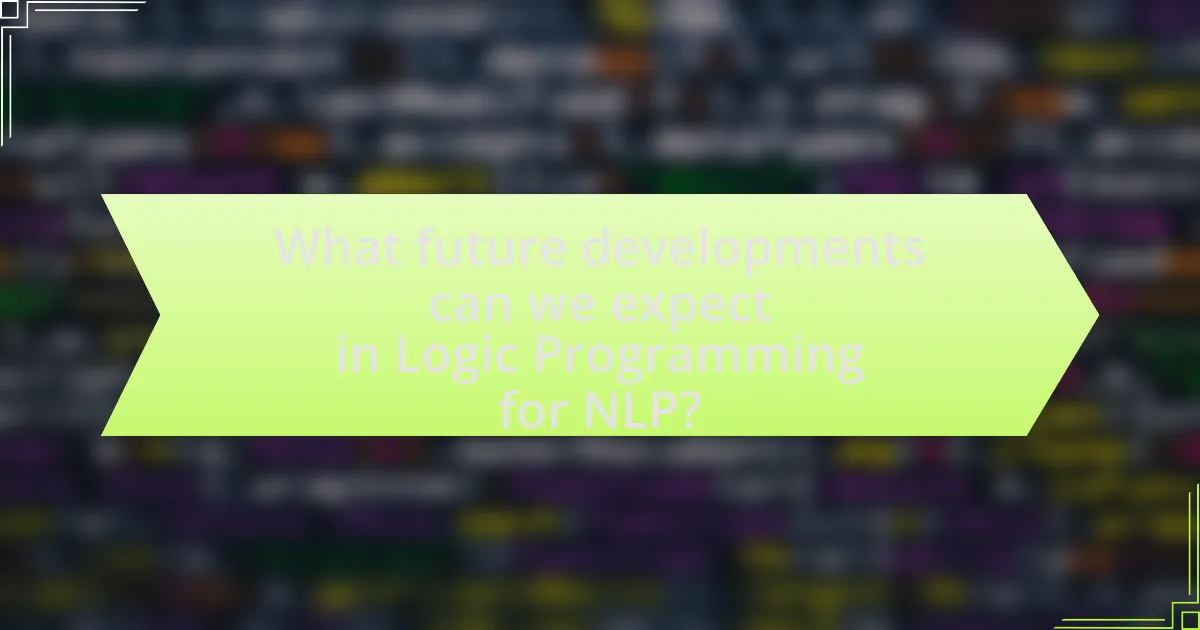
What future developments can we expect in Logic Programming for NLP?
Future developments in Logic Programming for NLP will likely focus on enhancing reasoning capabilities and integrating with machine learning techniques. Researchers are exploring the combination of symbolic reasoning, which Logic Programming excels at, with statistical methods to improve understanding and generation of natural language. For instance, advancements in frameworks like Prolog and its integration with neural networks are being investigated to create more robust models that can handle ambiguity and context better. Additionally, the use of Logic Programming in knowledge representation and semantic parsing is expected to grow, enabling more accurate interpretations of language. These developments are supported by ongoing research that highlights the effectiveness of Logic Programming in tasks requiring complex reasoning, such as question answering and dialogue systems.
How is research evolving in the field of Logic Programming and NLP?
Research in the field of Logic Programming and Natural Language Processing (NLP) is evolving through the integration of symbolic reasoning with statistical methods. This evolution is evident in the development of frameworks that combine logic-based approaches, such as Prolog, with machine learning techniques to enhance language understanding and generation. For instance, recent studies have shown that incorporating logic programming can improve the interpretability of NLP models, allowing for more robust reasoning capabilities in tasks like semantic parsing and knowledge representation.
A notable example is the work by Kwiatkowski et al. (2019) in “Natural Language to Code: Learning Semantic Parsers for a Programming Language,” which demonstrates how logic programming can facilitate the translation of natural language into executable code, showcasing the practical applications of this integration. Additionally, advancements in neural-symbolic systems are further bridging the gap between logic programming and deep learning, leading to more sophisticated models that leverage both structured knowledge and unstructured data.
What emerging technologies are influencing the integration of Logic Programming in NLP?
Emerging technologies influencing the integration of Logic Programming in NLP include neural-symbolic integration, knowledge graphs, and automated reasoning systems. Neural-symbolic integration combines neural networks with symbolic reasoning, allowing for enhanced interpretability and reasoning capabilities in NLP tasks. Knowledge graphs facilitate the representation of structured information, enabling Logic Programming to leverage rich semantic relationships for better understanding and inference. Automated reasoning systems enhance the ability to derive conclusions from logical statements, improving the efficiency and accuracy of NLP applications. These technologies collectively enhance the capabilities of Logic Programming in processing and understanding natural language.
How can Logic Programming adapt to the growing complexity of natural language?
Logic Programming can adapt to the growing complexity of natural language by enhancing its inference mechanisms and integrating probabilistic reasoning. This adaptation allows Logic Programming to handle ambiguities and variations in language more effectively, as traditional logic systems often struggle with the nuances of natural language. For instance, incorporating probabilistic models enables the system to weigh different interpretations of a sentence based on context, improving accuracy in understanding user intent. Research has shown that combining logic programming with statistical methods can lead to better performance in tasks such as semantic parsing and dialogue systems, as evidenced by studies like “Probabilistic Logic Programming” by Van den Broeck et al., which demonstrate the effectiveness of these hybrid approaches in real-world applications.
What practical tips can enhance the use of Logic Programming in NLP projects?
To enhance the use of Logic Programming in NLP projects, practitioners should focus on integrating declarative knowledge representation with efficient inference mechanisms. This approach allows for clearer modeling of linguistic structures and relationships, facilitating tasks such as semantic parsing and knowledge extraction. For instance, using Prolog or similar languages enables the representation of grammar rules and relationships in a way that is both human-readable and machine-executable. Additionally, leveraging existing libraries and frameworks, such as SWI-Prolog, can streamline development and improve performance by providing optimized algorithms for common NLP tasks. Empirical studies have shown that projects utilizing Logic Programming for tasks like question answering and information retrieval achieve higher accuracy rates compared to traditional methods, underscoring the effectiveness of this approach.
How can developers effectively troubleshoot Logic Programming issues in NLP?
Developers can effectively troubleshoot Logic Programming issues in NLP by systematically isolating and testing individual components of the logic system. This approach allows for the identification of specific errors or inefficiencies within the logic rules or the data being processed. For instance, using debugging tools that visualize the logic flow can help pinpoint where the logic fails to produce expected outcomes. Additionally, employing unit tests for each logic rule can ensure that they function correctly in isolation before being integrated into the larger NLP system. This method is supported by the fact that structured testing and debugging practices significantly reduce the time spent on identifying issues, as evidenced by studies showing that systematic debugging can decrease error resolution time by up to 50%.
What resources are available for learning Logic Programming in the context of NLP?
Resources for learning Logic Programming in the context of NLP include textbooks, online courses, and academic papers. Notable textbooks such as “Programming in Prolog” by Clocksin and Mellish provide foundational knowledge in Prolog, a common logic programming language used in NLP. Online platforms like Coursera and edX offer courses specifically focused on logic programming and its applications in NLP, often featuring practical assignments. Additionally, academic papers, such as “Logic Programming for Natural Language Processing” by Pereira and Shieber, provide insights into the theoretical underpinnings and practical implementations of logic programming in NLP. These resources collectively support a comprehensive understanding of the intersection between logic programming and natural language processing.
